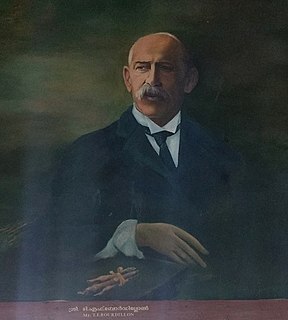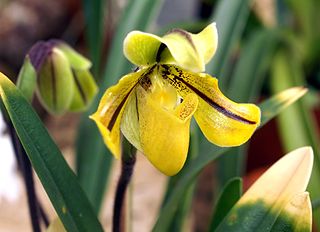
The Kingdom of Travancore, also known as the Kingdom of Thiruvithamkoor, was an Indian kingdom from c. 1729 until 1949. It was ruled by the Travancore Royal Family from Padmanabhapuram, and later Thiruvananthapuram. At its zenith, the kingdom covered most of modern-day southern Kerala, and the southernmost part of modern-day Tamil Nadu with the Thachudaya Kaimal's enclave of Irinjalakuda Koodalmanikyam temple in the neighbouring Kingdom of Cochin. However Tangasseri area of Kollam city and Anchuthengu near Attingal in Thiruvananthapuram district, those were British colonies, were parts of Malabar District.

The Madras Presidency, or the Presidency of Fort St. George, and also known as Madras Province, was an administrative subdivision (presidency) of British India. At its greatest extent, the presidency included most of southern India, including the whole of the Indian state of Andhra Pradesh, and parts of Tamil Nadu, Kerala, Karnataka, Telangana, Odisha and the union territory of Lakshadweep. The city of Madras was the winter capital of the Presidency and Ootacamund or Ooty, the summer capital. The Island of Ceylon was a part of Madras Presidency from 1793 to 1798 when it was created a Crown colony. Madras Presidency was neighboured by the Kingdom of Mysore on the northwest, Kingdom of Cochin on the southwest, and the Kingdom of Hyderabad on the north. Some parts of the presidency were also flanked by Bombay Presidency (Konkan) and Central Provinces and Berar.

The Third Anglo–Mysore War (1790–1792) was a conflict in South India between the Kingdom of Mysore and the East India Company, Kingdom of Travancore, Maratha Empire, and the Nizam of Hyderabad. It was the third of four Anglo–Mysore Wars.
Colonel Richard Henry Beddome was a British military officer and naturalist in India, who became chief conservator of the Madras Forest Department. In the mid-19th century, he extensively surveyed several remote and then-unexplored hill ranges in Sri Lanka and south India, including those in the Eastern Ghats such as Yelandur, Kollegal, Shevaroy Hills, Yelagiri, Nallamala Hills, Visakhapatnam hills, and the Western Ghats such as Nilgiri hills, Anaimalai hills, Agasthyamalai Hills and Kudremukh. He described many species of plants, amphibians, and reptiles from southern India and Sri Lanka, and several species from this region described by others bear his name.

Thomas Fulton Bourdillon was a British-Indian botanist, who worked as a Conservator of Forests in the princely state of Travancore.

Robert Wight MD FRS FLS was a Scottish surgeon in the East India Company, whose professional career was spent entirely in southern India, where his greatest achievements were in botany – as an economic botanist and leading taxonomist in south India. He contributed to the introduction of American cotton. As a taxonomist he described 110 new genera and 1267 new species of flowering plants. He employed Indian botanical artists to illustrate many plants collected by himself and Indian collectors he trained. Some of these illustrations were published by William Hooker in Britain, but from 1838 he published a series of illustrated works in Madras including the uncoloured, six-volume Icones Plantarum Indiae Orientalis (1838–53) and two hand-coloured, two-volume works, the Illustrations of Indian Botany (1838–50) and Spicilegium Neilgherrense (1845–51). By the time he retired from India in 1853 he had published 2464 illustrations of Indian plants. The standard author abbreviation Wight is used to indicate this person as the author when citing a botanical name.

Cullenia is a genus of flowering plants native to India and Sri Lanka. Earlier classification schemes place the genus in the kapok-tree family (Bombacaceae), but the Angiosperm Phylogeny Group places it in the mallow family (Malvaceae).

Edgar ThurstonCIE was a superintendent at the Madras Government Museum who contributed to studies in the zoology, ethnology and botany of India and published works related to his work at the museum. Thurston was educated in medicine and lectured in anatomy at the Madras Medical College while also holding his position at the museum. His early works were on numismatics and geology and these were followed by researches in anthropology and ethnography. He succeeded Frederick S. Mullaly as the superintendent of ethnography for the Madras Presidency.
Diwan Bahadur Cozhisseri Karunakara Menon (1863–1922) was an Indian journalist and politician from the erstwhile Madras Presidency. He was the second editor of The Hindu after G. Subramania Iyer and the founder of the Indian Patriot.

Khan Bahadur Sir Muhammad Habibullah KCSI KCIE was an Indian politician and administrator who served as the Dewan of Travancore from 1934 to 1936.

North Malabar refers to the geographic area of southwest India covering the state of Kerala's present day Kasaragod and Kannur Districts, the Mananthavady taluk of Wayanad District, the taluk of Vatakara in the Kozhikode District of Kerala and the entire Mahé Sub-Division of the Union Territory of Puducherry.

Paphiopedilum druryi is a species of orchid endemic to the Agastyamalai Hills of southern India. It is the only southern Indian orchid species in the genus. Rediscovered in 1972 after its original description in 1870, wild populations were decimated by commercial collectors and it is one of the few plants that are listed as threatened by the Indian government and included in CITES and the IUCN Redlist.

Lieutenant General Sir Robert Garrett KCB KH was Commander of British Troops in China and Hong Kong.
Diwan Bahadur Sir Mannath Krishnan NairKCIE (1870–1938) was an Indian politician from the Indian National Congress and later, Justice Party who served as a member of the Madras Legislative Council and later, executive council of the Governor of Madras. He also served as the Chief Justice of Travancore High Court and later Diwan of Travancore from 1914 to 1920
The Travancore rebellion against the British East India Company was led by the prime ministers of the Indian states of Travancore and Cochin in 1808–09.

The Mysorean invasion of Malabar was the military invasion of Malabar region of current Kerala state, including the territories of the Zamorin of Calicut, by the de facto ruler of the Kingdom of Mysore Hyder Ali. After completing the occupation, Kingdom of Cochin, situated south of Malabar, was made a tributary state of Mysore. The major reason for the occupation of Malabar was the desire to have access to Indian Ocean ports. The Mysore invasion provided the East India Company more chances to tighten their grip on the ancient feudal principalities of Malabar and converting Travancore, over whom Mysore Sultans attacked after Cochin, to a mere protected ally

General James Welsh was an English officer in the Madras Army of the East India Company.

Surgeon General George BidieCIE was a British physician who worked in India in the Madras Medical Service. He was also Superintendent of the Government Museum, Chennai from 1872 to 1885.

Major General William Cullen was a British Army Officer with the Madras Artillery Regiment, and from 1840 to 1860, Resident in the Kingdom of Travancore and Cochin. During his stay in India, he took a scholarly interest in the region and contributed to journals on geology, plants and the culture of the region. He was instrumental in establishing the Napier Museum in Trivandrum. He died at Allepey in Kerala, where a road is named after him.
















